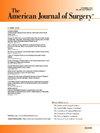预测一级创伤患者的院内肺炎风险:利用创伤质量改进计划进行外部验证研究。
IF 2.7
3区 医学
Q1 SURGERY
引用次数: 0
摘要
背景:及早发现有可能患上非典型肺炎的患者,就有机会采取预防措施,从而提高生存率并降低成本。因此,本研究旨在对现有的预测模型(由 Croce 等人发布)进行外部验证,以预测美国一级创伤中心收治的患者中是否会出现院内肺炎:一项回顾性队列研究,包括2013-2015年和2017-2019年期间入住一级创伤中心并在美国全国创伤登记处TQIP登记的患者。研究的主要结果是第一阶段的总霍乱性肺炎和第二阶段的呼吸机相关肺炎(VAP)。在重新校准前后对模型的辨别力和校准进行了评估:研究对象包括902231名创伤患者(2013-2015年=180601人;2017-2019年=721630人),两个时期的中位年龄均为52岁,64-65%为男性,约90%为钝性创伤。受伤严重程度评分中位数为 13 分(2013-2015 年)和 9 分(2017-2019 年);格拉斯哥昏迷量表评分中位数为 15 分。非典型肺炎发病率为4.4%,VAP发病率为0.7%。原始模型在这两个时期均表现出良好至卓越的判别能力(c-统计量2013-2015年为0.84,95%CI为0.83-0.84;c-统计量2017-2019年为0.92,95%CI为0.91-0.92)。重新校准后,较低预测概率的判别能力和校准能力均有所提高:结论:Croce 模型可以识别美国一级创伤中心收治的具有全院性肺炎和 VAP 风险的患者。在创伤临床实践中实施(修改后的)Croce 模型可指导明智地使用预防措施和处方额外的非侵入性预防措施(如加强监测、肺部理疗),以减少高危患者的鼻腔肺炎发生率。本文章由计算机程序翻译,如有差异,请以英文原文为准。
Predicting nosocomial pneumonia risk in level-1 trauma patients: An external validation study using the trauma quality improvement program
Background
Early identification of patients at risk of nosocomial pneumonia enables the opportunity for preventative measures, which may improve survival and reduce costs. Therefore, this study aimed to externally validate an existing prediction model (issued by Croce et al.) to predict nosocomial pneumonia in patients admitted to US level-1 trauma centers.
Methods
A retrospective cohort study including patients admitted to level-1 trauma centers and registered in the TQIP, a US nationwide trauma registry, admitted between 2013–2015 and 2017–2019. The main outcome was total nosocomial pneumonia for the first period and ventilator-associated pneumonia (VAP) for the second. Model discrimination and calibration were assessed before and after recalibration.
Results
The study comprised 902,231 trauma patients (N2013–2015 = 180,601; N2017–2019 = 721,630), with a median age of 52 in both periods, 64–65 % male, and approximately 90 % sustaining blunt traumatic injury. The median Injury Severity Scores were 13 (2013–2015) versus 9 (2017–2019); median Glasgow Coma Scale scores were 15. Nosocomial pneumonia incidence was 4.4 %, VAP incidence was 0.7 %. The original model demonstrated good to excellent discrimination for both periods (c-statistic2013–2015 0.84, 95%CI 0.83–0.84; c-statistic2017–2019 0.92, 95%CI 0.91–0.92). After recalibration, discriminatory capacity and calibration for the lower predicted probabilities improved.
Conclusions
The Croce model can identify patients admitted to US level-1 trauma centers at risk of total nosocomial pneumonia and VAP. Implementing (modified) Croce models in route trauma clinical practice could guide judicious use of preventative measures and prescription of additional non-invasive preventative measures (e.g., increased monitoring, pulmonary physiotherapy) to decrease the occurrence of nosocomial pneumonia in at-risk patients.
求助全文
通过发布文献求助,成功后即可免费获取论文全文。
去求助
来源期刊
CiteScore
5.00
自引率
6.70%
发文量
570
审稿时长
56 days
期刊介绍:
The American Journal of Surgery® is a peer-reviewed journal designed for the general surgeon who performs abdominal, cancer, vascular, head and neck, breast, colorectal, and other forms of surgery. AJS is the official journal of 7 major surgical societies* and publishes their official papers as well as independently submitted clinical studies, editorials, reviews, brief reports, correspondence and book reviews.

 求助内容:
求助内容: 应助结果提醒方式:
应助结果提醒方式:


